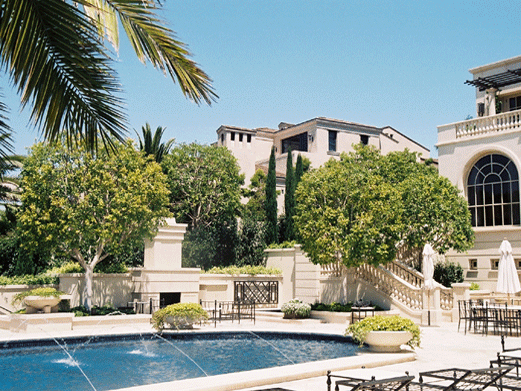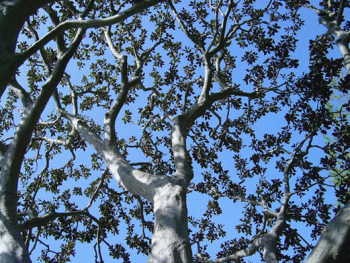
These skills are developed with years of experience in the field and provide the ability to ‘see’ future growth and development of the tree. This vision is the foundation of our advanced pruning techniques. Once a care plan is developed, proper tools and techniques are utilized to direct or redirect growth properly and safely.
Working in accordance with the latest ANSI pruning standards, ArborWest™ strives to enhance the beauty, structural integrity and functional value of your trees.
Learn more about our Tree Services and Professional Pruning Practices
Why Prune Your Trees?
Trees require pruning for several reasons:
- Improves natural form and appearance.
- Improves branch spacing.
- Strengthens branch attachment.
- Invigorates or slows branch growth rate.
- Improves stability by reducing wind resistance.
- Removes dead, weakened, injured, diseased or insect-damaged branches.
- Increases lighting to the interior.
- Reduces hazard potential.
Topping Trees (Never!)
Why Never Top Your Trees?Topping trees often give the owner a misguided sense of safety. Trees that are topped are more likely to fail than trees that have been properly pruned. There is never a good reason to top a tree.*
Tree biology is often is over looked by bargain tree companies. Bargain tree companies tend to over prune trees because it is faster to make larger chainsaw cuts than to use a pole pruner on a tree. Chainsaw trimming trees takes less time and is cheaper than pole pruning your trees because we all know – time is money. Topping promotes abnormal growth patterns. This abnormal growth is not attached to the structural wood of tree and is more likely to fail.
We often give estimates where the customer ask for the tree to be ‘topped’ or says the tree is to tall. We educate our clients on the pitfalls to this style of pruning and guild them in the correct manner of tree preservation. Height or size of the tree does not equal danger. Trees become dangerous when many factors come into equation such as; un-maintained tree, improper trimming (topping), wind, rain, root damage, construction damage, over watering, lack of watering and the like.
Unscrupulous tree companies will give you what you ask for without informing you of the long term damage you will cause your tree by topping it. Trees are an investment to your property and should be protected. Anyone who states that they ‘top’ trees in their literature or verbally should not be considered if you truly care about your trees. BE CAREFULL WHAT YOU ASK FOR!
* Trees are topped away from power lines for electrical safety but the practice harms the tree and leads to an unsafe growth pattern. We do not recommend planting trees under powerlines.
Tree Removal
Determining whether a tree is enhancing or diminishing the value of your property is the key to deciding whether it has shifted from being an asset to a liability. This determination should help decide whether to opt for tree preservation or tree removal.A tree can enhance the value of your property in two distinct ways. One benefit is aesthetic, as trees can beautify a property and create curb appeal. Trees also enhance value in a practical manner by providing shade, privacy, and wind protection. The value of a properly placed, aesthetically correct mature tree is immeasurable as it often provides both beauty and function while being nearly impossible to replace.A tree becomes a liability when it detracts from the value of your property. Most tree removal stems from a lack of foresight on the part of landscapers and landscape architects. In order to compensate for a lack of mature trees, many Landscape Architects will over plant a property to give it the look of an established landscape. While this usually starts off beautifully, down the line, the mature trees end up crowded and competing for space. This often leads to poor growth patterns leaving the trees vulnerable to disease and pests. Considering the size of a tree at maturation in relation to the rest of the landscape prior to planting will prevent considerable problems down the line.Tree removal is often the only option when it becomes cost prohibitive to maintain a tree. This is often the only option when a tree is causing structural damage to a home or building that cannot be easily rectified. This also occurs when a tree is sick, damaged, or structurally weak to the extent that it would be extremely difficult or impossible to correct.While trees are sometimes removed for aesthetic reasons, it should be considered that tree removal is final and will usually take years of re-growth to replace.
Insects & Tree Disease
Tree disease and infestation can be caused by many factors. Trees that are stressed are much more likely to get sick or infested by insects or other predators. Stress factors include under watering, over watering, compacted soil, nutrient poor soil, infestation and improper pruning. All insects seek out susceptible hosts (sick trees/plants) to feed upon. Most trees that die prematurely have one or more of these problems that cause its final demise.Proper care and preventative maintenance is key to the longevity and health of a tree. These things include skilled pruning, watering, and proper fertilizing is critical in maintaining good heath in your trees. An ounce of prevention is worth a pound of cure!Trees immune systems release a pheromone when they are sick in order to combat problems. Unfortunately, this is like a beacon to hungry insects in the area. The severe downward spiral in the trees health (and appearance) often happens when more than one pest, condition or disease enters the tree. Healthy trees can fight one pest or disease but they struggle when attacked from multiple sources.A typical scenario is that the tree becomes stressed by under watering over a period of time. Now the tree releases pheromones and aphids get the call and attack full force because the tree is weak. The tree has become so sick that it becomes infected by beetles that attack under the bark – finally killing the tree.We often get calls for help long after the tree is very sick or even completely dead. As we mentioned earlier, the time to treat sick trees is early. Early treatment is often the only opportunity to reduce die back in the tree. A healthy tree can recover faster from these malaise, reducing the likelihood of other pest or disease entering the tree.Most uneducated tree companies do not treat diseased or insect infested trees – they usually will just prune them with the standard trimming procedure. This not only is bad for the sick tree, but the blade or chainsaw spreads the disease throughout the tree and any other trees the blade comes into contact with. Only a skilled full service tree company should treat sick trees.
Production Pruning vs. Ornamental Pruning
Production Pruning“The bitterness of poor quality lingers on long after the sweetness of a low bid is forgotten.” Anonymous
When trees are trimmed ‘production style’ it causes undo stress to be placed on the tree. Production style pruning leads to a undesirable growth patterns. The long term results of this style can be very detrimental to trees, leaving them more susceptible to a host of problems including insect infestation, disease or even branch failure. When compared with the non-aggressive style of ornamental pruning, the long term cost of maintaining your tree can doubled or even tripled.
The cost of maintaining trees can not be measured by just the price of a single trimming. The style of pruning determines the price of your bid. In turn, the amount of time spent in each tree determines the quality of the prune. The long term harm caused to your trees by a cheap bid (or production pruning), should be taken into consideration before you let just anyone with a truck and chainsaw cut your trees. Measuring the value of structural integrity, aesthetics, and resilience of your tree is important in evaluating the true cost of maintenance over the life of the tree.
Planning for the future growth of your trees is paramount for their structural integrity and beauty. With proper pruning and maintenance, the life expectancy of your trees can be assured. Less is more; by making small cuts in the crown of the tree, growth is directed in the proper direction. Small cuts heal sooner than large cuts, reducing the chance of decay entering the tree. Remember the quote above when considering a low bid for your tree care – you will pay more in the future, guaranteed!
Arborists Links
- Select a Tree by Characteristics – UFEI
- International Society of Arboriculture
- Tree Care Industry Association
- American Society of Consulting Arborists
- American Horticultural Society
- Sims Tree Learning Center
- BioBarrier
- USDA Plant Database – Select a Tree

